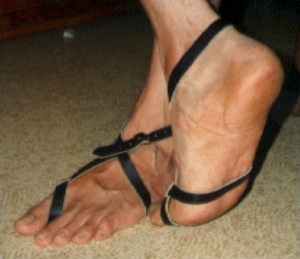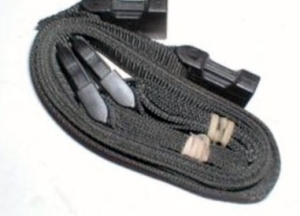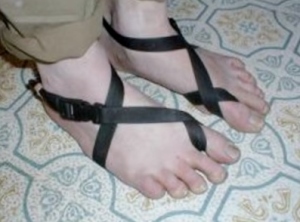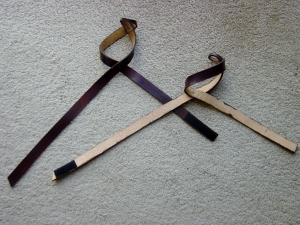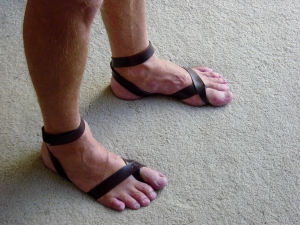Q24: Is there such a thing as soleless footwear?
Yes! They are called “barefoot sandals,” “soleless sandals,” or simply “barebottoms.” They are really just a strap of leather or other material worn to make it appear to a casual observer that we’re wearing sandals even though our soles and toes remain naturally and comfortably bare and in contact with the ground or floor.
Experience with them indicates that they do in fact fool people, the “No Bare Feet” crowd being the chief target. The theory is that an observer’s brain doesn’t notice anything unusual in peripheral vision, not enough to glance down. People who do glance down may feel too stupid asking a question even though they may realize that “something’s wrong with this picture.”
Several examples of barefoot sandals that can easily be constructed are shown below.
1) VERSION USING LEATHER STRAPS
One type that can be constructed with thin leather straps. This is a picture and description by the original designer, which should enable someone to make their own or enable a local craftsperson to make a pair.
A pair of 1/2″ x 33″ leather straps with a buckle on one end and a couple of small slits with brass studs along the way. The idea was to thread the strap around your big toe and arch passing through the slits on the way. Viola! Something that looked like a sandal but wasn’t. Perfect to get into a “No shoes, No service” spot. Made in 1967 for the anti-establishment soleless folks.
2) VERSION MADE FROM NYLON UTILITY STRAPS commonly used by backpackers and others.
This is a pair of pre-cut 42″ x 3/4″ accessory straps, complete with side-release buckles, purchased at a local outfitter’s store (in this case, REI) for probably just $3.50. These seem to work just fine as-is, with no modifications whatsoever. The slits used in the leather barefoot sandals above seem to be completely unnecessary; in fact, I think that they’re more free to adjust to different foot positions without them.
The visual effect (from above) is something like a Teva sandal. I didn’t bother trimming off the extra length; I just used rubber bands to hold the folded-up free end fast to the strap behind the buckle. After all, they might be useful as accessory straps when not being worn on the feet :-).
They go on very quickly: Just hold the rubber-banded part against the outside of the ankle with one hand, with the free end of the strap coming out at your Achilles’ tendon. With the other hand, wrap the strap over the ankle, across the top of the foot, across the sole, around the big toe, and finally clip it together.
3) ANOTHER VARIATION USING LEATHER STRAPS has a slightly different construction and wrapping pattern:
I got my material from the Tandy Leather store. If there is no store near you, they have a website where it can be ordered. The leather strips are called “Natural Cowhide Strips, 3/4 inch” and are listed under “Belt Blanks without Snaps.” I got the 50″ lengths. They also carry 72″ lengths.
First thing I did was dye the outside of the strips dark brown. Then at about the middle of each strip I placed it under my big toe, wrapped it around crossing on top, then down around my foot, crossing underneath my foot at about where my arch is, then back behind my heel crossing again, then around to the front of my ankle.
I found that due to the thickness and width of the material, the part going around the toe needs to be a lot narrower to look and feel right. I trimmed it so that it kind of tapers to roughly 1/4″ around my toe at the bottom.
Initially, I just fastened the leather strips around my ankle with a heavy paper clip and wore them a while around the house. Then I decided that they needed more stability, so I sewed some stitches into the loop where it crosses my big toe at the top, also stitched where it crosses underneath my foot. Once I was satisfied that it all fit and worked OK, I made final trims on the ends of the strips and sewed on Velcro to keep them fastened around my ankles.
At first, they were just a little uncomfortable – they hurt around my toe, and they hurt a little underneath where the leather crossed under my arch. A little Vaseline helped a lot as I wore them around the house for several days. It didn’t take very long until they began to feel fine. I have now worn them out in public for hours at a time without any problem or any discomfort.
4) HAND-MADE VARIATION USING LEATHER MATERIALS
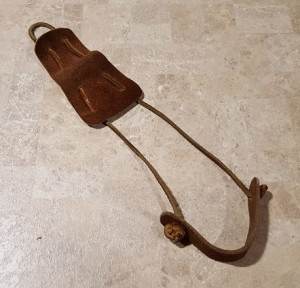
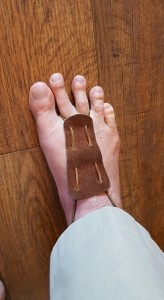 The maker of this hand-made version created them using a standard leather sheet and leather straps available at any craft store.
The maker of this hand-made version created them using a standard leather sheet and leather straps available at any craft store.
Simply cut to size and shape the top and back (heel) sections from a standard leather sheet. Punch holes into the top section (four sets of two holes) and into the back section (two holes, one at each end) as visible in the photos. Finally, thread the leather strap through the holes and tie a knot at each end, allowing just enough length to fit the size for your foot.
5) ANOTHER CREATIVE OPTION
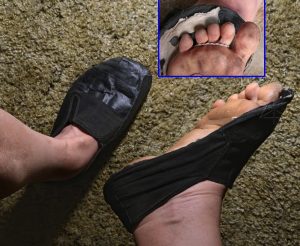 The person who repurposed these shoes calls them “Fakeout shoes!”
The person who repurposed these shoes calls them “Fakeout shoes!”
They consist of a modified pliable shoe with the sole cut out and a toe strap added (see the inset photo at left) to keep it in place on the foot.
This version also slips conveniently into a pocket when not in use.
6) STILL MORE OPTIONS–FOR WOMEN: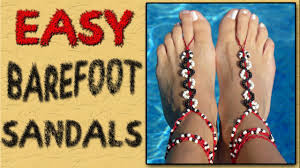
Watch this video on how to make your own stylish barefoot sandals for women
OPTIONS AVAILABLE ONLINE:
Many designers and sellers of “soleless footwear” feature their products online. Search for “barefoot sandals,” “soleless sandals,” or “barebottom sandals.” Two examples below:
Barebottoms 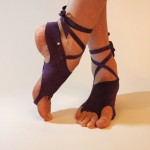
Handcrafted in Canada. Designed by SBL member Sue Kenney.
Watch a film by Sue Kenney on how Barebottoms redefine footwear.
_______________
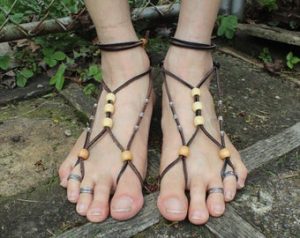 Chux Barefoot Sandals
Chux Barefoot Sandals
Numerous barefoot (soleless) sandal designs for men and women (mostly men), sold by another SBL member.

